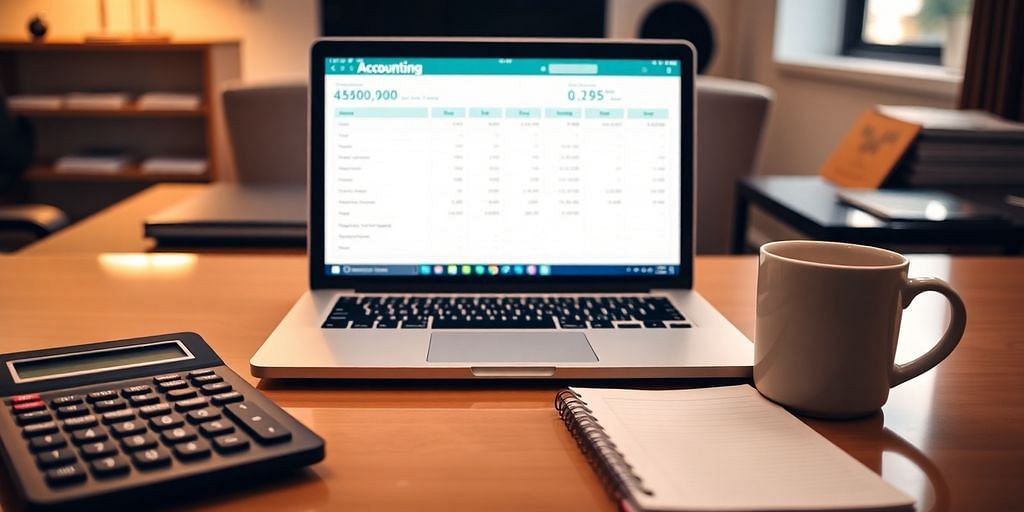
The Ultimate Guide to Choosing Accounting Software for Your Business Success
Back To BlogUnderstanding Your Business Needs
Before we dive into the world of accounting software, we need to get a good grip on what our business actually needs. This is like trying to pick the perfect pair of shoes—you need to know your size, style, and what you’ll be using them for. Let’s break it down.
Identifying Industry-Specific Requirements
Every industry has its quirks, right? So, if we’re running a retail shop, we might need software that plays nice with our point-of-sale system. A construction biz? Well, we’d probably be looking at features that help us track expenses for each project. Here are some examples:
- A bakery might focus on inventory management to keep track of ingredients.
- A consulting firm may prioritize time tracking and client billing.
- A restaurant could need robust sales reporting and employee scheduling features.
Considering the Size of Your Business
The size of our business is a biggie when choosing software. A small startup might just need basic invoicing and expense tracking. But if we’re talking about a growing company with more employees, then payroll and detailed financial reporting become essential.
- Small Businesses: Look for solutions with basic invoicing, expense tracking, and simple financial reports.
- Medium Businesses: Consider software that offers payroll, multi-user access, and advanced reporting.
- Large Enterprises: Opt for comprehensive systems with extensive customization, scalability, and integration capabilities.
Evaluating Financial Literacy Needs
Let’s be real, not everyone on our team is going to be an accounting whiz. So, if we’re not all experts, we’ll want something user-friendly with plenty of support. Here’s what to think about:
- Beginner-Friendly: Look for intuitive interfaces, easy-to-navigate dashboards, and plenty of tutorials.
- Advanced Users: Seek out software with in-depth features and customization options that can handle complex financial tasks.
Understanding our unique needs is crucial for choosing the right accounting software. It helps us avoid wasting time and money on solutions that don’t fit our business.
By taking the time to assess these factors, we can make a more informed decision and find software that truly meets our needs, ensuring better management and achievement of our business goals.
Key Features to Look For in Accounting Software
When we're on the hunt for accounting software, there are some features that are just non-negotiable. Let's dive into what we should be looking for.
Automation and Efficiency
Who doesn't love saving time? Automated invoicing is a lifesaver, sending out bills on its own so we can focus on other stuff. And when it comes to tracking expenses, the software should let us categorize costs and snap receipts easily. It's like having a personal assistant that never takes a break.
Integration Capabilities
Our accounting software should play nice with the other tools we use. Whether it's connecting with our CRM or syncing with our online store, seamless integration keeps everything running smoothly. This way, we can avoid the hassle of jumping between different platforms.
User-Friendly Interface
We all appreciate software that's easy to use, right? A user-friendly interface means even those of us who aren't tech wizards can navigate it without a hitch. Plus, having mobile access is a big win, letting us check our accounts anytime, anywhere.
Prioritizing these features ensures we choose accounting software that not only fits our present needs but also grows with us. This way, managing our finances becomes less of a chore and more of a breeze.
By focusing on these aspects, we can find the perfect accounting software that will support our business as it expands. After all, the right tools make all the difference in keeping our financial house in order. Efficient invoice processing is a key feature that enhances financial management and ensures timely payments.
Balancing Cost and Features

Choosing the right accounting software is like finding the perfect pair of shoes. It’s all about getting the right fit without breaking the bank. Here's how we can make sure we’re not just throwing money at the first flashy option we see.
Setting a Realistic Budget
First things first, let’s nail down a budget. We don’t want to get carried away with all the bells and whistles only to find out we’ve spent way too much. Think about what we can realistically afford, then stick to it. Here’s a simple approach:
- Identify core needs: What must the software absolutely do? Make a list.
- Consider future growth: Will our needs change as we expand?
- Factor in hidden costs: Setup fees, support charges, and more can sneak up on us.
Comparing Pricing Plans
Now that we’ve got a budget, it’s time to compare the pricing plans of different software providers. Some might offer more bang for our buck, while others might not be worth the extra cash. When evaluating vendor pricing, keep an eye on:
- Freemium vs. Premium: Some offer basic features for free, but charge for advanced tools.
- Tiered subscriptions: Look at what each tier offers. Sometimes the middle option is just right.
- One-time purchase vs. subscription: Decide if we want to pay once or prefer a monthly fee.
Consulting with Financial Advisors
Let’s not forget the power of a second opinion. Consulting with financial advisors can give us insights we might not have considered. They can help us understand the long-term implications of our choice, ensuring we get the best deal possible. It’s like having a trusted friend guide us through the maze of options.
Remember, the right accounting software isn’t just a tool—it’s a partner in our business success. Taking the time to balance costs and features can lead to better financial management and growth.
In the end, it’s about finding that sweet spot where cost and features meet. We don’t want to skimp on essentials, but we also don’t want to pay for stuff we’ll never use. By setting a budget, comparing plans, and getting expert advice, we’re setting ourselves up for success. Let’s make sure we’re making a choice that’s both smart and sustainable.
Testing and Finalizing Your Choice

Taking Advantage of Free Trials
Before we commit to any accounting software, it's smart to take it for a test drive. Most providers offer free trials, so we can explore the features and see if they fit our business needs. During this trial period, let's pay attention to how intuitive the software is and whether it integrates smoothly with our existing systems. This hands-on experience is invaluable and can prevent future headaches.
Gathering Feedback from Your Team
Once we've tried out the software, it's time to loop in the team. After all, they're the ones who'll be using it day in and day out. Let's gather their thoughts on user-friendliness, any potential issues, and whether it meets their daily needs. A quick survey or a team meeting can work wonders here. Their feedback is crucial in making a well-rounded decision.
Making the Final Decision
Now that we've done our homework and listened to the team, it's decision time. We should weigh the pros and cons, considering both the technical aspects and the team's input. It's about finding the right balance between cost, features, and usability. Remember, the goal is to choose software that not only fits our budget but also boosts productivity and efficiency.
Choosing the right accounting software is like finding a good pair of shoes – it needs to fit just right and support us in all the right places. Let's make sure we're stepping forward with confidence.
Frequently Asked Questions
What should I think about when picking accounting software?
When choosing accounting software, consider your business needs, budget, and must-have features. Make sure the software fits what your business specifically requires.
Is there a best accounting software for small businesses?
There's no one-size-fits-all answer. The best accounting software for a small business depends on its unique needs, budget, and the features it requires.
Why is accounting software important for my business?
Accounting software is important because it helps track income and expenses, reduces errors, and provides insights for better decision-making. It makes managing finances easier and more accurate.
